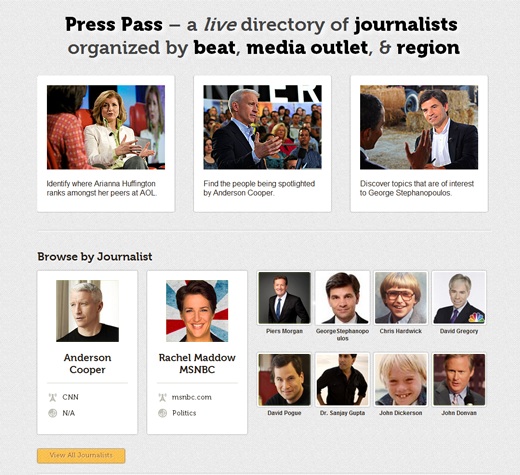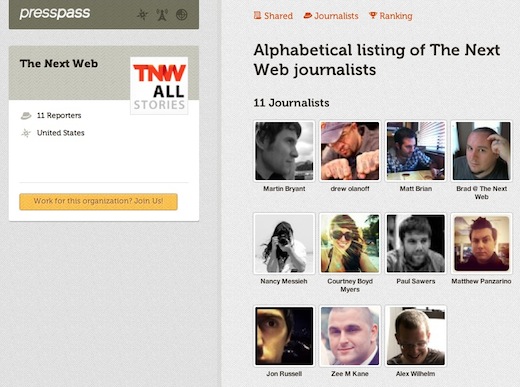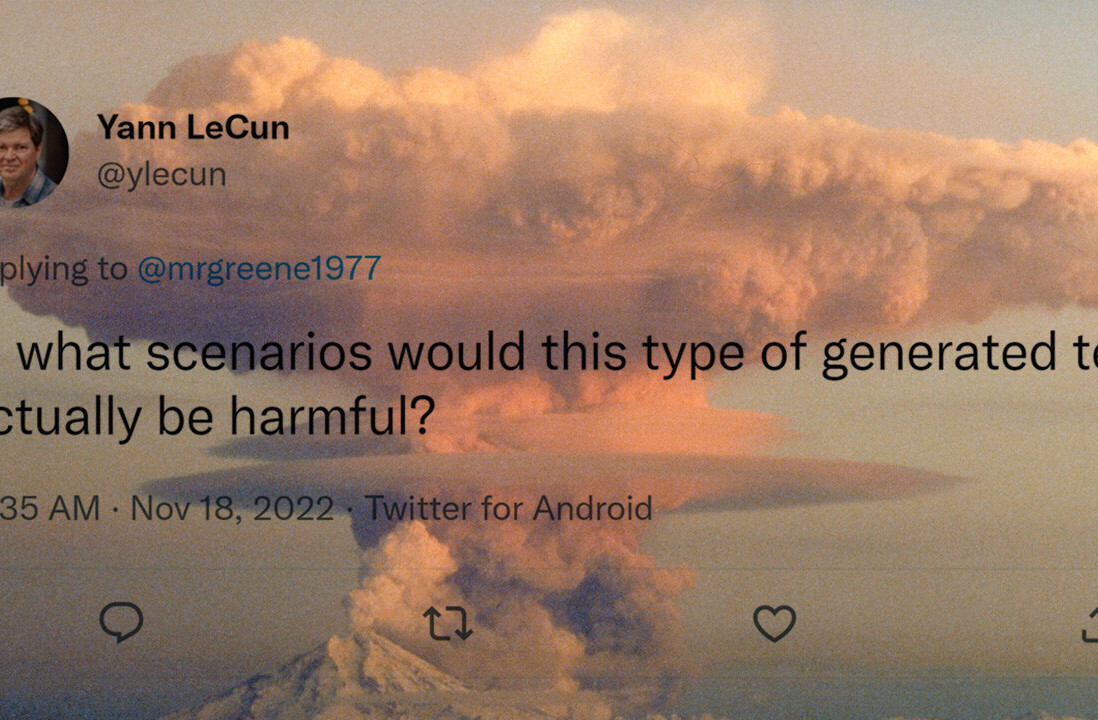
Press Pass, a ‘live directory’ of journalists from major publications, is a brand new Dubai-based site that comes to us courtesy of co-founders David Haddad, a product manager and software engineer, and Valencio Cardoso, an interactive designer.
The site lists journalists by region, beat or by publication, making it incredibly easy to find the journalist who can cover your story. Not only can you find out which journalists work at major publications and sites, you can connect with them through Twitter. You can also find out what they’re personally interested in, as Press Pass highlights the stories that they’re sharing through their Twitter feed.
The site analyzes each journalist’s tweets, creating a profile based on that content – including what they’re reading, topics they’re interested in and who they’re talking to. Each journalist is ranked based on the number of followers they have and their number of tweets.
Press Pass essentially does three things – it gives users a way to find out which journalists work for which publications, while also giving them a better idea of what those journalists are interested in, and provides a possible mode of communication – through Twitter.
An Interview with the co-founder
The Next Web caught up with co-founder, Valencio to find out more about the site and its plans for the future, as well as his thoughts on connecting with journalists through Twitter.
The first thing we were curious about, when it came to Press Pass, was the inspiration behind launching the site. Valencio explained:
Regardless of social media, we feel that journalists are still behind large amounts of information the public is exposed to every day. A big part of their job is to filter and package information sourced from the community around them.
At the same time, there is a large subset of people who are looking to get their message out to the public. Non-profits, small businesses, citizen reporters, startups, etc. We feel that the process for them to do so isn’t very straightforward and can be quite cumbersome.
David and I wanted to make that interaction between journalists and their community more pleasant and efficient for everyone involved and the Press Pass directory is our first step in that direction – a single platform for both sides to connect.
It’s hard to avoid the comparison to the New York-based startup, MuckRack, which we have covered in the past here, but Valencio points out that there are significant differences in the way the two sites operate:
At the moment, like MuckRack, Press Pass is an aggregated directory, where we’re adding journalists strategically and vetting them based on a certain criteria – they must be a professional journalist, who is employed by a recognized news, media or broadcasting organization, etc.
We feel that a lot of the things that MuckRack is charging for at the moment should be more advanced and unique. For example, to access journalists by beat, you have to pay. Our goal with Press Pass is for people to find the right journalists who are relevant to their stories, and closing access to important information goes against that idea.
Ultimately David and I want to align Press Pass’ success, with the success of the people using the site. We’re looking to create a system that provides real value to journalists by getting them relevant and unique stories. At the same time, we want to provide ways for regular people to get featured in the news. Once we start getting closer to that goal, then we will think of ways to generate revenue because at that point we’ll be providing something that’s not only tangible, but valuable to everyone involved.
More to come from Press Pass
There are still many more features that can be expected from Press Pass. The very next step will be to add journalists from other regions around the world, and with the founders based in the Middle East, that’s where they’re looking next. They will also be creating a “PressPass 100” section, a constantly updated list of the top journalists, categorized by both beat and region.
But that is not all Press Pass has planned. Valencio explains:
We will also be creating affinity hub pages geared towards specific groups of people, like artists, Kickstarter projects, small businesses, citizen reporters, nonprofits, etc., with specific tips and best practices on the right ways to approach journalists.
Also, as we continue adding new journalists from all across the world, we’re open to the idea of releasing an API that lets others build interesting products targeted at helping the journalists in our directory.
Press Pass is trying to change the way that journalists interact with businesses and startups looking to get coverage. The Next Web, an example, has taken a very open approach, with each writer placing their email address in their online bios on the site, but as Valencio points out, that isn’t always the case. He says,
It’s great that TNW is putting their info online, because many publications aren’t open to that yet, but I’m seeing more and more news organizations pushing their journalist’s Twitter handles.
Right now Press Pass is just an aggregated directory, however as we start seeing more engagement, we’re going to allow journalists to sign up, edit their profile info, tell people which is the best channel to reach out to them, and also what kind of stories they’re interested in covering.
For startups, knowing how to contact a journalist is just the first step in getting your story published. Regardless of the method you choose, be sure to check out our startup guide to getting coverage.
Should you contact journalists via Twitter?
While Press Pass is encouraging users to get in touch with journalists through Twitter, the practice might not necessarily be welcomed by all. In a recent article on Forbes, several journalists explicitly said that they don’t want to be contacted via Facebook, Twitter or other forms of social media, whereas others were open to the idea.
In the Forbes article, Andreas Kluth of The Economist brings up an interesting analogy:
“If they see me picnicking on a Sunday in the park with my family, would they come over, sit down on our blanket and pitch me a press release? Online, it is the same thing.”
Matt Krantz of USA Today has found a middle ground when it comes to being contacted via social media:
“It’s OK to contact a journalist via social media sites, as long as the online persona is one tied to work.”
So where should the line be drawn? With an ever increasing number of online profiles and social networks to publicly interact on, it becomes very easy for that line to be blurred. And regardless of whether or not journalists are open to the idea, contacting anyone through a tweet, you do run the risk of having your message lost in the midst of all the Twitter noise.
Asking Valencio for his take on the matter, he said:
Twitter is a medium that a lot of journalist and people in the media are really excited about. It’s been the source for a lot of breaking news stories, and people find it to be a great way of keep a pulse of what’s happening around them. A lot of journalists are also using it to follow up with leads, do their research, and even find their next story.
Another positive with using Twitter for people to pitch their stories is that they’re doing it publicly, so journalists are less likely to get spammed. It also forces the person to be concise with their message, and the fact that it’s short means that it’ll take less time for the journalist to evaluate whether they should follow up.
Having said that, we do realize that there is a subset of stories that need to be handled privately by journalists for whatever reason, so as more people use Press Pass we’re open to creating different channels of communication.
Is Press Pass ahead of its time?
Press Pass may simple be ahead of the curve, offering users a service that will one day be standard in the world of media and journalism. After all, when Twitter was first unveiled, it was no doubt hard to imagine that the social network would become a serious journalistic tool or the home of breaking news, as was the case with the killing of Osama Bin Laden or the death of Whitney Houston.
While the lines are still being forged of how Twitter should or should not be used in journalism, sites like Press Pass place a new question on the table – is it acceptable to contact a journalist for a story via social media?
There are certain guidelines that are worth bearing in mind. If you’ve already contacted a journalist via email, following up on Twitter to see if they’ve received it can often send the wrong message. It’s also advisable to take a look at their Twitter feed and see how closely tied it is to their work as a journalist.
Twitter gives its users direct access to celebrities, journalists, and other professions, which in the past have been something of a walled garden. Press Pass has introduced an interesting question of just how ‘open’ should that garden be?
Little tips and inquiries via Twitter might certainly be acceptable, but 140 characters doesn’t leave much room to tell your whole story. If you choose not to contact a journalist via Twitter, Press Pass certainly makes it easier to get on the trail of finding out which journalist is best suited to cover your story, after which you can figure out how they prefer to be contacted.
Do you think it’s acceptable for journalists to be contacted via Twitter? Let us know what you think in the comments.
Get the TNW newsletter
Get the most important tech news in your inbox each week.







